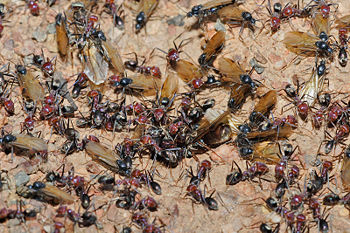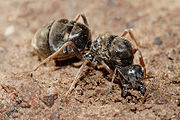
Nuptial flight
Encyclopedia

Ant
Ants are social insects of the family Formicidae and, along with the related wasps and bees, belong to the order Hymenoptera. Ants evolved from wasp-like ancestors in the mid-Cretaceous period between 110 and 130 million years ago and diversified after the rise of flowering plants. More than...
, termite
Termite
Termites are a group of eusocial insects that, until recently, were classified at the taxonomic rank of order Isoptera , but are now accepted as the epifamily Termitoidae, of the cockroach order Blattodea...
and some bee
Bee
Bees are flying insects closely related to wasps and ants, and are known for their role in pollination and for producing honey and beeswax. Bees are a monophyletic lineage within the superfamily Apoidea, presently classified by the unranked taxon name Anthophila...
species. During the flight, virgin queens mate
Mate
Mate may refer to one of the following meanings based on the generic dictionary definitions of the word:* One of a pair of animals involved in mating* Mate , a colloquialism used to refer to a friend* A naval officer:...
with males and then land to start a new colony, or, in the case of honey bee
Honey bee
Honey bees are a subset of bees in the genus Apis, primarily distinguished by the production and storage of honey and the construction of perennial, colonial nests out of wax. Honey bees are the only extant members of the tribe Apini, all in the genus Apis...
s, continue the planned succession of an existing hived colony.
Before the flight

Egg (biology)
An egg is an organic vessel in which an embryo first begins to develop. In most birds, reptiles, insects, molluscs, fish, and monotremes, an egg is the zygote, resulting from fertilization of the ovum, which is expelled from the body and permitted to develop outside the body until the developing...
will develop into males. Fertilized eggs usually develop into wingless, sterile workers, but may develop into virgin queens if the larva
Larva
A larva is a distinct juvenile form many animals undergo before metamorphosis into adults. Animals with indirect development such as insects, amphibians, or cnidarians typically have a larval phase of their life cycle...
e receive special attention.
Within a few days after they have emerged (eclosed) from the pupa
Pupa
A pupa is the life stage of some insects undergoing transformation. The pupal stage is found only in holometabolous insects, those that undergo a complete metamorphosis, going through four life stages; embryo, larva, pupa and imago...
case, males are "quickly converted into single-purpose sexual missiles." Young queens and males stay in their parent colony until conditions are right for the nuptial flight. The flight requires clear weather since rain is disruptive for flying insect
Insect
Insects are a class of living creatures within the arthropods that have a chitinous exoskeleton, a three-part body , three pairs of jointed legs, compound eyes, and two antennae...
s. Different colonies of the same species often use environmental cues to synchronize the release of males and queens so that they can mate with individuals from other nests, thus avoiding inbreeding
Inbreeding
Inbreeding is the reproduction from the mating of two genetically related parents. Inbreeding results in increased homozygosity, which can increase the chances of offspring being affected by recessive or deleterious traits. This generally leads to a decreased fitness of a population, which is...
. The actual "take off" from the parent colony is also often synchronized so that predators cannot eat the ants one by one.
During the flight
Typically the virgin queens and males first scatter to ensure outcrossingOutcrossing
Outcrossing is the practice of introducing unrelated genetic material into a breeding line. It increases genetic diversity, thus reducing the probability of all individuals being subject to disease or reducing genetic abnormalities...
. The queens then release pheromone
Pheromone
A pheromone is a secreted or excreted chemical factor that triggers a social response in members of the same species. Pheromones are chemicals capable of acting outside the body of the secreting individual to impact the behavior of the receiving individual...
s to attract males. However, the queens often try to escape the males, allowing only the fastest and the fittest males to mate. Mating takes place during flight.
One queen will usually mate with several males. The sperm
Sperm
The term sperm is derived from the Greek word sperma and refers to the male reproductive cells. In the types of sexual reproduction known as anisogamy and oogamy, there is a marked difference in the size of the gametes with the smaller one being termed the "male" or sperm cell...
is stored in a special organ, known as a spermatheca, in the queen's abdomen and will last throughout her lifetime. This can be as long as 20 years, during which time the sperm
Sperm
The term sperm is derived from the Greek word sperma and refers to the male reproductive cells. In the types of sexual reproduction known as anisogamy and oogamy, there is a marked difference in the size of the gametes with the smaller one being termed the "male" or sperm cell...
can be used to fertilize tens of millions of eggs
Egg (biology)
An egg is an organic vessel in which an embryo first begins to develop. In most birds, reptiles, insects, molluscs, fish, and monotremes, an egg is the zygote, resulting from fertilization of the ovum, which is expelled from the body and permitted to develop outside the body until the developing...
.
After the flight

The young mated queens land and, in the case of ants, remove their wings. They then attempt to found a new colony. The details of this vary from species to species, but typically involve the excavation of the colony's first chamber and the subsequent laying of eggs
Egg (biology)
An egg is an organic vessel in which an embryo first begins to develop. In most birds, reptiles, insects, molluscs, fish, and monotremes, an egg is the zygote, resulting from fertilization of the ovum, which is expelled from the body and permitted to develop outside the body until the developing...
. From this point the queen continuously lays eggs which hatch into larvae, exclusively destined to develop into worker ants. The queen usually nurses the first brood alone. After the first workers appear, the queen becomes strictly an egg-laying machine. For an example of a colony founding process, see Atta sexdens
Atta sexdens
Atta sexdens is a species of leafcutter ant belonging to the tribe Attini. Atta species are native to the New World, from Southern United States to Northern Argentina in the South. They are absent from Chile. They cut leaves to provide a substrate for the fungus farms which are their principal...
.
The young queens have an extremely high failure rate. During its lifetime a very large ant colony can send out millions of virgin queens. Assuming that the total number of ant colonies in the area remains constant, on average only one of these queens will succeed. The rest are destroyed by predators (most notably other ants), environmental hazards or failures in raising the first brood at various stages of the process. This strict selection ensures that the queen has to be both extremely fit and extremely lucky to pass on her gene
Gene
A gene is a molecular unit of heredity of a living organism. It is a name given to some stretches of DNA and RNA that code for a type of protein or for an RNA chain that has a function in the organism. Living beings depend on genes, as they specify all proteins and functional RNA chains...
s to the next generation.
Variations
Not all ants follow the basic pattern described above. In army antArmy ant
The name army ant is applied to over 200 ant species, in different lineages, due to their aggressive predatory foraging groups, known as "raids", in which huge numbers of ants forage simultaneously over a certain area, attacking prey en masse.Another shared feature is that, unlike most ant...
s only males have wings. They fly out from their parent colony in search of other colonies where virgin queens wait for them. A colony with an old queen and one or more mated young queens then divides, each successful queen taking a share of the workers. The reason for this behavior is the fact that army ants do not have a physical nest. The queens are thus absolutely dependent on workers to protect them.
Another variation is found in species with multi-queen colonies, such as Solenopsis invicta
Red imported fire ant
See main article Fire ant.The red imported fire ant , or simply RIFA, is one of over 280 species in the widespread genus Solenopsis...
. The males and virgin queens mate and the queens then often return to the parent colony, where they will then remain. This process greatly increases the success rate of virgin queens and allows the creation of extremely large colonies or networks of cooperating colonies. The colony also becomes essentially immortal as it is no longer dependent on the continued health of a single queen. This allows Solenopsis invicta colonies to become entrenched in their surroundings, achieving a dominant position in the ecosystem. However, the price for this is inbreeding
Inbreeding
Inbreeding is the reproduction from the mating of two genetically related parents. Inbreeding results in increased homozygosity, which can increase the chances of offspring being affected by recessive or deleterious traits. This generally leads to a decreased fitness of a population, which is...
and the resulting loss of adaptability. This may result in sudden collapses in population when the environment changes or a new predator or parasite is introduced.
Flying ant day
"Flying ant day" is an informal term for the day on which queen ants emerge from the nest to begin their nuptial flight. In most species, the male ants also fly alongside them, although they are smaller and less noticeable. The queens fly around—some very long distances, and others going only a few meters—then mate, and drop to the ground where they lose their wings, and attempt to start a new ant colonyAnt colony
An ant colony is an underground lair where ants live, eat and mate. Colonies consist of a series of underground chambers, connected to each other and the surface of the earth by small tunnels. There are rooms for nurseries, food storage, and mating...
The mass of flying insects often attracts the attention of predators such as birds, and it is common to see flocks of feeding birds gorging on the readily available food.
This phenomenon occurs in many colonies simultaneously when the local weather conditions are appropriate, to reduce the effectiveness of predation and to ensure that the queens and males from different colonies stand a chance of meeting and interbreeding. It therefore has the appearance of being a 'timed' event or that the ants somehow communicate. However neither of these is likely to be the case - it is simply a common response to temperature, humidity and windspeed and time of year.
In October 2009, a swarm of flying ants briefly disrupted play between innings at cricket matches during the ICC Champions trophy, in South Africa. The matches were the semi-final between Australia and England, and the ensuing final between Australia and New Zealand, both day-night 50 over games.
External links
- Starting an ant colony with queens captured from a nuptial flight
- How an Ant Colony starts
- antbase.org Information on ant species
- On Flying Ants Colorado State University Cooperative Extension specialist, entomology

